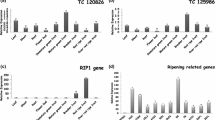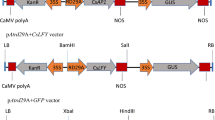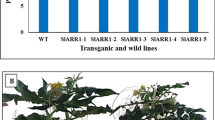Abstract
Important agronomic traits such as fruit quality, harvesting efficiency or production largely depend on flowering time. We have analysed the effect of the overexpression of the Arabidopsis APETALA1 MADS-box gene on vegetative and reproductive growth of tomato. Constitutive expression of APETALA1 in tomato plants has major effects on the length of their growth cycle as well as on their growth habit. Transgenic tomato plants initiated flowering after the production of 6 vegetative nodes as compared to 11 nodes for the wild type plants. Most of tomato 35S:AP1 plants also showed determinate growth habit, similar to the phenotype of self pruning tomato mutants, as well as an initial reduction of their axillary growth. Moreover, development and fertility of flowers were not affected in plants expressing AP1. Consequently, fruit formation in transgenic plants grown under greenhouse conditions occurred normally, which permitted a similar fruit yield compared to control plants. Since traits conferred by AP1 expression are dominant, its expression in tomato breeding lines could provide advantages for the development of new hybrid varieties with shorter generation time, determinate growth, and reduced pruning requirements.
Similar content being viewed by others
References
Amaya I., Ratcliffe O. J. and Bradley D. J. 1999. Expression of CENTRORADIALIS(CEN) and CEN-like genes in tobacco re-veals a conserved mechanism controlling phase change in diverse species. Plant Cell. 11: 1405–1417.
Atherton J. G. and Harris G. P. 1986. Flowering. In: Atherton J. G. and Rudich J. (eds), The Tomato Crop. Chapman and Hall, New York/London, pp. 167–200.
Ausubel F. M., Brent R., Kingston R. E., Moore D. D., Seidman J. G., Smith J. A. and Struhl K. 1995. Current Protocols in Molecular Biology. John Wiley and Sons, London, UK.
Baulcombe D. C., Saunders G. R., Bevan M. B. and Harrison B. D. 1986. Expression of biologically active viral satellite RNA from the nuclear genome of transformed plants. Nature 321: 446–449.
Beck E., Ludwig G., Auerswald E. A., Reiss B. and Schaller H. 1982. Nucleotide sequence and exact localization of the neomy-cin phosphotransferase gene from transposon Tn5. Gene 19: 327–336.
Bradley D., Ratcliffe O., Vincent C., Carpenter R. and Coen E. 1997. Inflorescence commitment and architecture in Arabidop-sis. Science 275: 80–83.
Ellul P., Garcia-Sogo B., Pineda B., Ríos G., Roig L. A. and Moreno V. 2003. The ploidy level of transgenic plants in Agrobacterium-mediated transformation of tomato cotyledons(Lycopersicon es-culentum L. Mill.( is genotype and procedure dependent. Theor. Appl. Genet. 106: 231–238.
Grandillo S., Zamir D. and Tanksley S. D. 1999. Genetic improve-ment of processing tomatoes: A 20 years perspective. Euphytica 110: 85–97.
He Z., Zhu Q., Dabi T., Li D., Weigel D. and Lamb C. 2000. Transformation of rice with the Arabidopsis floral regulator LEAFY causes early heading. Transgenic Research 9: 223–227.
Iglesias V. A., Moscone E. A., Papp I., Neuhuber F., Michalowski S., Phelan T., Spiker S., Matzke M. and Matzke A. J. 1997. Mo-lecular and cytogenetic analyses of stably and unstably expressed transgene loci in tobacco. Plant Cell 9: 1251–1264.
Kooter J. M., Matzke M. A. and Meyer P. 1999. Listening to the si-lent genes: transgene silencing, gene regulation and pathogen control. Trends Plant Sci. 4: 340–347.
MacArthur J. W. 1932. Inherited characters in tomato. I. The self pruning habi t. J. Hered. 23: 394–395.
Malayer J. C. and Guard A. T. 1964. A comparative developmental study of the mutant side-shootless and normal tomato plants. Am. J. Bot. 51: 140–143.
Mandel M. A., Gustafson-Brown C., Savidge B. and Yanofsky M. 1992. Molecular characterization of the Arabidopsis floral homeotic gene APETALA1. Nature 36: 273–377.
Mandel M. A. and Yanoksky M. 1995. A gene triggering flower formation in Arabidopsis.:Nature 377: 522–524.
Molinero-Rosales N., Jamilena M., Zurita S., Gómez P., Capel J. and Lozano R. 1999. FALSIFLORA, the tomato orthologue of FLORICAULA and LEAFY, controls flowering time and floral meristem identity. Plant J. 20: 685–693.
Moudarov A., Cremer F. and Coupland G. 2002. Control of flow-ering time: interacting pathways as a basis for diversity. Plant Cell S111-S130 (Supplement 2002).
Murashige T. and Skoog F. 1962. A revised medium for rapid growth and bioassays with tobacco tissue cultures. Physiol. Plant. 1: 473–479.
Nagy F., Kay S. A. and Chua N. H. 1988. Analysis of gene expres-sion in transgenic plants. In: Gelvin S. B. and Schilperoort R. A. (eds), Plant Molecular Biology Manual. Kluwer Academic Pub-lishers, Dordrecht, The Netherlands, pp. 1–29.
Peña L., Martin-Trillo M., Juarez J., Pina J. A., Navarro L. and Martinez-Zapater J. M. 2001. Constitutive expression of Arabi-dopsis LEAFY or APETALA1 genes in citrus reduces their gen-eration time. Nature Biotech. 19: 263–267.
Pnueli L., Carmel-Goren L., Hareven D., Gutfinger T., Alvarez J., Ganal M., Zamir D. and Lifschitz E. 1998. The self-prunning gene of tomato regulates vegetative to reproductive switching of sympodial meristems and is the ortholog of cen and tfl1. Devel-opment 125: 1979–1989.
Rottmann W. H., Meilan R., Sheppard L. A., Brunner A. M., Skinner J. S., Ma C., Cheng S., Jouanin L., Pilate G. and Srauss S. H. 2000. Diverse effects of overexpression of LEAFY and PTLF, a poplar(Populus) homolog of LEAFY/FLORICAULA, in trans-genic poplar and Arabidopsis. Plant J. 22: 235–245.
Sawhney V. K. and Greyson R. I. 1972. On the initiation of the in-florescence and floral organs in tomato(Lycopersicon esculen-tum). Ca n. J. Bot. 50: 1493–1495.
Schumacker K., Schmitt T., Rossberg M., Schmitz G. and Theres K. 1999. The Lateral suppressor(Ls) gene of tomato encodes a new member of the VHIID protein family. Proc. Natl. Acad. Sci. USA 96: 290–295.
Simpson G. G. and Dean C. 2002. Arabidopsis, the Rosetta stone of flowering time? Science 296: 285–289.
Smulders M. J. M., Rus-Kortekaas W. and Gilissen L. J. W. 1995. Natural variation in patterns of polysomaty among individual tomato plants and their regenerated progeny. Plant Science: 106: 129–139.
Stevens M. A. and Rick C. M. 1986. Genetics and Breeding. In: Atherton J. G. and Rudich J. (eds), The Tomato Crop. Chapman and Hall, New York/London, pp. 35–109.
Tucker D. J. 1977. Hormonal regulation of lateral bud outgrowth in the tomato. Plant Sci. Lett. 8: 105–111.
Wang R-L., Stec A., Hey J., Lukens L. and Doebley J. 1999. The limits of selection during maize domestication. Nature 398: 236–239.
Weigel D. and Nilsson O. 1995. A developmental switch sufficient for flower initiation in diverse plants. Nature 377: 495–500.
Yeager A. F. 1927. Determinate growth in the tomato. J. Hered. 18: 263–365.
Author information
Authors and Affiliations
Corresponding author
Rights and permissions
About this article
Cite this article
Ellul, P., Angosto, T., García-Sogo, B. et al. Expression of Arabidopsis APETALA1 in tomato reduces its vegetative cycle without affecting plant production. Molecular Breeding 13, 155–163 (2004). https://doi.org/10.1023/B:MOLB.0000018763.64585.6b
Issue Date:
DOI: https://doi.org/10.1023/B:MOLB.0000018763.64585.6b




